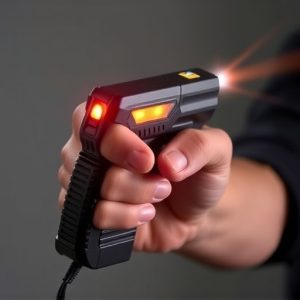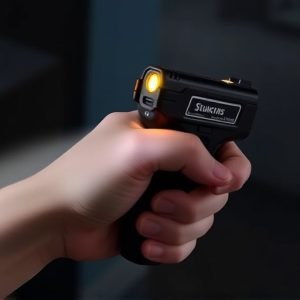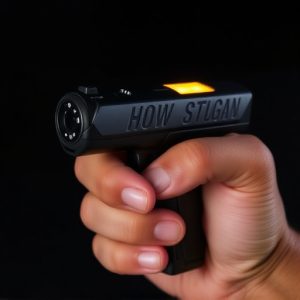Handheld Electrical Self-Defense Weapons: A Comprehensive Comparison & Buying Guide (How Stun Guns Work)
A stun gun, or taser, uses high-voltage, low-amperage electric current delivered through metal probe…….
A stun gun, or taser, uses high-voltage, low-amperage electric current delivered through metal probes to temporarily disable attackers by disrupting neuromuscular signals. Easy to use with a simple trigger mechanism, they offer a non-lethal self-defense solution. Understanding their power output, pulse width, and legal aspects is crucial when choosing them for personal safety, alongside other options like pepper spray or personal alarms.
“Discover the power of personal protection with our comprehensive guide to handheld electrical self-defense weapons. We explore the inner workings of stun guns and their effectiveness as self-defense tools, breaking down various types available in the market today. From understanding the science behind electric shocks to navigating legal aspects, this article ensures you’re informed about choosing the best device for your safety needs. Learn how these innovative gadgets work, their pros and cons, and make an informed decision on staying secure.”
- What is a Handheld Electrical Self-Defense Weapon?
- How Does a Stun Gun Work?
- Types of Handheld Self-Defense Devices: A Comparison
- Safety and Legal Considerations for Stun Guns
- Choosing the Best Handheld Self-Defense Weapon for Your Needs
What is a Handheld Electrical Self-Defense Weapon?
A handheld electrical self-defense weapon, commonly known as a stun gun or taser, is a device designed for personal safety and protection against potential attackers. It operates by delivering an electric current through two metal probes connected to high-voltage, low-amperage electricity. When activated, the stun gun creates a powerful shock that temporarily disables the target, providing the user with time to escape or seek help.
Stun guns work on the principle of neuromuscular incapacitation, which disrupts the electrical signals in the body responsible for muscle control and coordination. This disruption causes muscular spasms and temporary paralysis, allowing the user to gain distance from an assailant. The device is easy to use, typically requiring a simple trigger pull or push, making it an accessible option for individuals seeking non-lethal self-defense solutions.
How Does a Stun Gun Work?
A stun gun, also known as an electronic control device (ECD), is designed to temporarily incapacitate an attacker through electrical disruption of their muscular control. It achieves this by delivering a powerful electric shock through two probes connected to high-voltage, low-amperage electricity. When activated, the stun gun generates a pulse that interferes with the nervous system’s ability to transmit signals to muscles, causing them to contract involuntarily. This results in the target experiencing muscle spasms, disorientation, and temporary paralysis, providing the user with enough time to escape or disable their assailant.
The effectiveness of a stun gun lies in its ability to stop an attacker without causing serious harm. The shock is intended to be painful but not lethal, focusing on non-lethal force to subdue and deter aggression. Modern stun guns use various technologies, including electrochemical and electromagnetic pulses, to ensure precise control over the intensity of the shock, making them a popular choice for personal defense in situations where firearms are not permitted or desirable.
Types of Handheld Self-Defense Devices: A Comparison
Handheld self-defense devices have evolved beyond traditional pepper spray, offering a range of options for personal safety. These tools are designed to provide individuals with the means to protect themselves in various situations. Among the most common types are stun guns, also known as electroshock weapons. A stun gun works by delivering a powerful electric current through two probes, temporarily incapacitating the target. This non-lethal force is used to disrupt muscle control, causing the person to drop and become immobile for several minutes.
Other options include personal alarms that emit high-decibel sounds and flashing lights, and self-defense keys or rings equipped with sharp edges or spikes. Some devices combine features, such as a stun gun with a built-in alarm or flashlight. Each type has its advantages and is suited to different needs, from everyday carry for women’s safety to specific situations like travel or outdoor activities. Understanding the mechanics and capabilities of these devices is crucial when choosing an effective self-defense tool.
Safety and Legal Considerations for Stun Guns
When considering handheld electrical self-defense weapons, understanding safety and legal aspects is paramount. Stun guns, or electronic control devices (ECDs), operate by delivering a powerful electric shock that temporarily disables an aggressor. The current interrupts nerve impulses to the muscles, causing muscle contractions and disorientation, allowing the user to escape. However, their effectiveness varies based on factors like power output, pulse width, and contact points.
Legally, stun guns are categorized differently across jurisdictions. Some countries and states permit them without a license, while others require registration or specific permits. It’s crucial to research local laws to ensure compliance and avoid potential legal repercussions. Safety precautions include proper training, understanding the device’s range and power settings, and keeping it out of reach of children and unauthorized individuals.
Choosing the Best Handheld Self-Defense Weapon for Your Needs
Choosing the best handheld self-defense weapon starts with understanding your specific needs and circumstances. Factors to consider include size, weight, ease of use, power, range, and legal restrictions in your area. For instance, stun guns are popular choices due to their non-lethal nature; they emit a strong electric shock that temporarily disables an assailant. Understanding how does a stun gun work is crucial—they typically use high voltage, low amperage electrical charges delivered through metal probes or contacts upon activation.
Other options include pepper spray, which uses capsaicin to cause pain and irritation, and personal alarm devices that utilize loud sounds and flashing lights to startle potential attackers. Each option has its pros and cons, so it’s essential to evaluate your personal safety needs and choose a device that offers the right balance of effectiveness, convenience, and legality for your situation.
When considering a handheld electrical self-defense weapon, understanding how a stun gun works is paramount. These devices utilize electric current to temporarily incapacitate an assailant, offering a non-lethal yet effective means of protection. By comparing different types and weighing safety and legal factors, you can choose the best handheld self-defense weapon tailored to your specific needs. Remember, armed with knowledge, staying safe becomes second nature.


